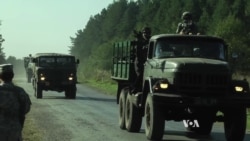The Ukrainian troops put on camouflage paint and hide in tall grass by the side of the road. They have information that an enemy convoy will be passing by soon.
Minutes later four trucks speed down the road and screech to a halt as bombs go off and the Ukrainian troops open fire. The enemy retreats and the Ukrainian soldiers congratulate each other on a successful mission.
But this is not the east, and this “enemy” is not a separatist force or Russian troops.
This is western Ukraine, and the “enemy” is a platoon of American soldiers, pointing their weapons and shouting, “Pow, pow, pow,” and then smiling as one smart aleck among them adds, “You guys are all dead, now.”
These troops are among the forces of 15 nations participating in an exercise called “Rapid Trident.” It is an annual event, but this year the drills have special meaning.
“We are having hard times in the east now,” said Ukrainian Army Cadet Mikhail Marchenko, referring to the fighting against rebels who have declared independence in two eastern provinces, supported by Russian forces.
“During military actions there, separatists and rebel groups are attacking our forces in the same way as reflected in these actions,” Marchenko said.
“We are trying now to get this stuff better within the troops,” said Ukrainian Navy Lieutenant Yevgeny Zabrodskiy, a veteran of the Ukrainian military collapse in Crimea in February, when Russia seized the peninsula.
“We have young people here so the more experienced guys they can give them some information,” he said. “They can train them. They can show them their mistakes so that they can work on that.”
But, he added that it is “one thing when we train them by ourselves, and another thing is to train them with the international community, who can help us, who can show us our minuses, advantages, disadvantages.”
"Rapid Trident", a reference to the Ukrainian national symbol, has brought together 1,300 troops from several NATO members, including Britain, Bulgaria, Germany, Lithuania, Poland, and Romania, as well as several other countries including Azerbaijan, Georgia and Moldova. The 12-day exercise focuses on combat skills like patrolling, countering improvised explosive devices, convoy operations, urban warfare and emergency medical evacuation.
Ukraine is not a NATO member, but in a speech to a joint meeting of the U.S. Congress on Thursday, President Petro Poroshenko asked for a special security status to facilitate military aid.
Ukraine is a NATO partner nation, and these exercises are taking place just 30 kilometers from the border of NATO member Poland, which announced on Thursday that it plans to create a joint military unit with Ukraine and NATO member Lithuania. The move would provide Ukrainian military units with more regular contact with NATO forces, but is well short of the security guarantees membership would provide.
For now, Ukraine’s parliament has adopted a non-alignment policy, but officials say that could change if the security situation worsens further.
Russian criticism
Russia has criticized this exercise, which was scheduled before the Russian-backed separatists started the hostilities in eastern Ukraine. Russian troops are holding exercises at the same time in several areas not far from Ukraine, and the country has strengthened its military positions near the border and in occupied Crimea.
At Ukraine’s National Security and Defense Council in Kyiv, analyst Volodymyr Poliovyi said, “This year besides the military component of training our troops, [Rapid Trident] also has a symbolic aspect. It means support. We really appreciate this support that members of NATO are showing us.”
“These drills also demonstrate the readiness of Ukrainian forces to receive aid quickly, incorporate it, and incorporate various types of weaponry and styles of command that meet NATO standards," Poliovyi said.
“We might do some things slightly different,” said U.S. Army Lieutenant Thomas Johnston after working with some Georgian troops here on how to clear a building of hostile forces. “But if we were to go do an operation together or train together, I think that would be fairly easy because we’re familiar with working with each other now.”









